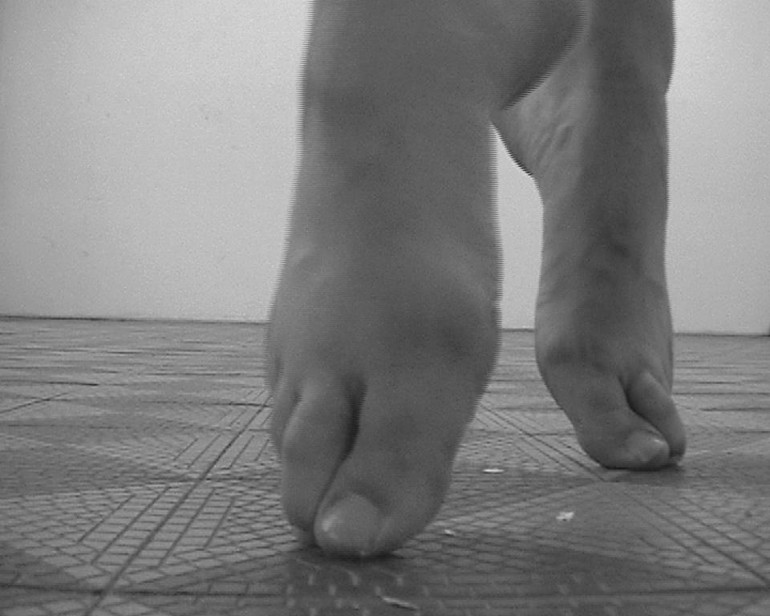

October 12, 2004
Opening: 12.10.2004, 6.00 pm
13.10.2004 – 10.11.2004
Red Square Dance sounds like the title of a Hollywood film. It may be a musical. Or a video clip. It lacks the kind of musical glamour though. Or the blatancy of a video clip. The peculiar story is told in a whisper. The first two are presented at a time: we have a close-up of toes filmed while pedicured, plus a dance, the choreographic order of which depends on the chequered pattern of the ceramic floor tiles. The chiropodial treatment by means of a file and pincers, a somewhat oppressive procedure, is a symbolic purification device in preparation for dancing. The pale, soft, fluffy fabric of the cloth on which the feet rest, is in sharp contrast to the hard, palpable coolness of the floor terracotta, the space in which the mysterious ritual is enacted. The ballerina’s movements are delicate and tender. They are also precise. She seeks to place her slightly raised feet on the darker squares that may be red, as suggested by the title. What she does is a little like a child’s play seeking to walk in such a way as not to cross the junction lines between the flagstones. The task becomes more difficult when she balances on her pointes (similar painstaking exercises are conducted for years by students of ballet schools). The releve position, an attempt at overcoming gravity and limitations of the body for the sake of beauty, must cause pain.
... putting a bare foot on the cold surface of tiles, we instinctively balance on the tops of our toes... The third sequence, presented as a separate projection, is a peculiar counterpoise of the former two. It features a view from above, in perspectival foreshortening. Permeated with lightness, the scene is unreal as in a dream, almost surrealistic. ... a feather is slowly falling on the floor.
The films are constructed in a simple way. They emanate silence. The kind of silence to which we can listen intently. The silence in Marzena Nowak’s films has its density, is an important narrative element. The economy of form and reduction of perceptive stimuli is conducive to concentration. The artist builds up tension employing elementary sensations and banal activities. She discovers them in a way, endowing them with meaning. She attentively watches details that we tend to ignore. She cuts out elements of reality. In close-up, zoomed in on what is apparently evident, becomes enigmatic and worthy of attention. Ordinary gestures imperceptibly become meaningful. Wrapped in an air of mystery, they become captivating in a way. An encounter with the molecules of existence, though it consists in granting them attention (so Jolanta Brach-Czaina), concerns our existence. It is as if the direction of our glance were reverted or our efforts were returned. It looks like the gratitude of things. When we try to understand the message conveyed by the existentially tangible, we finally come to understand ourselves. This may be because we are existentially tangible ourselves and it has come to a meeting of the existent, in which the contemporary meaning is revealed.